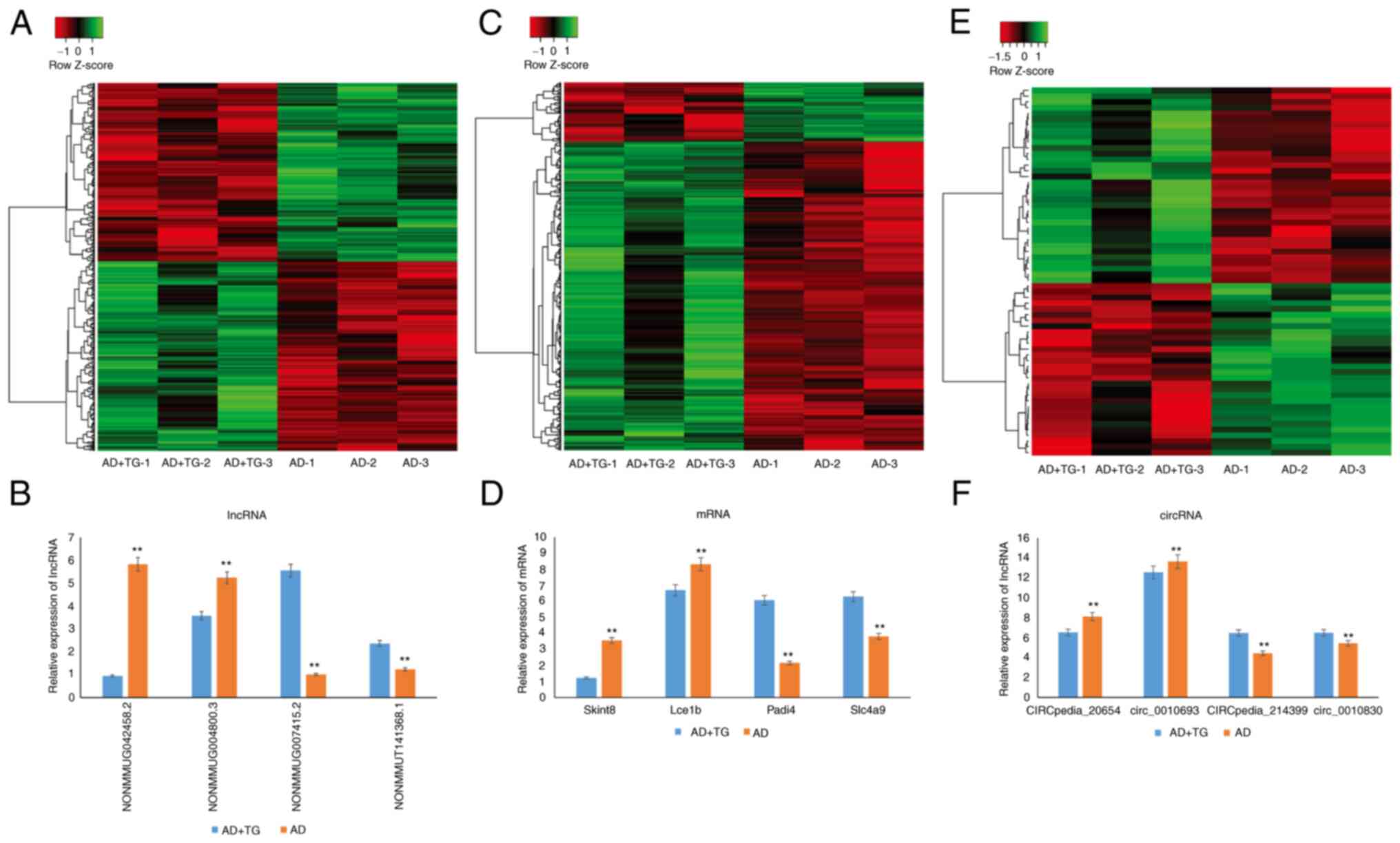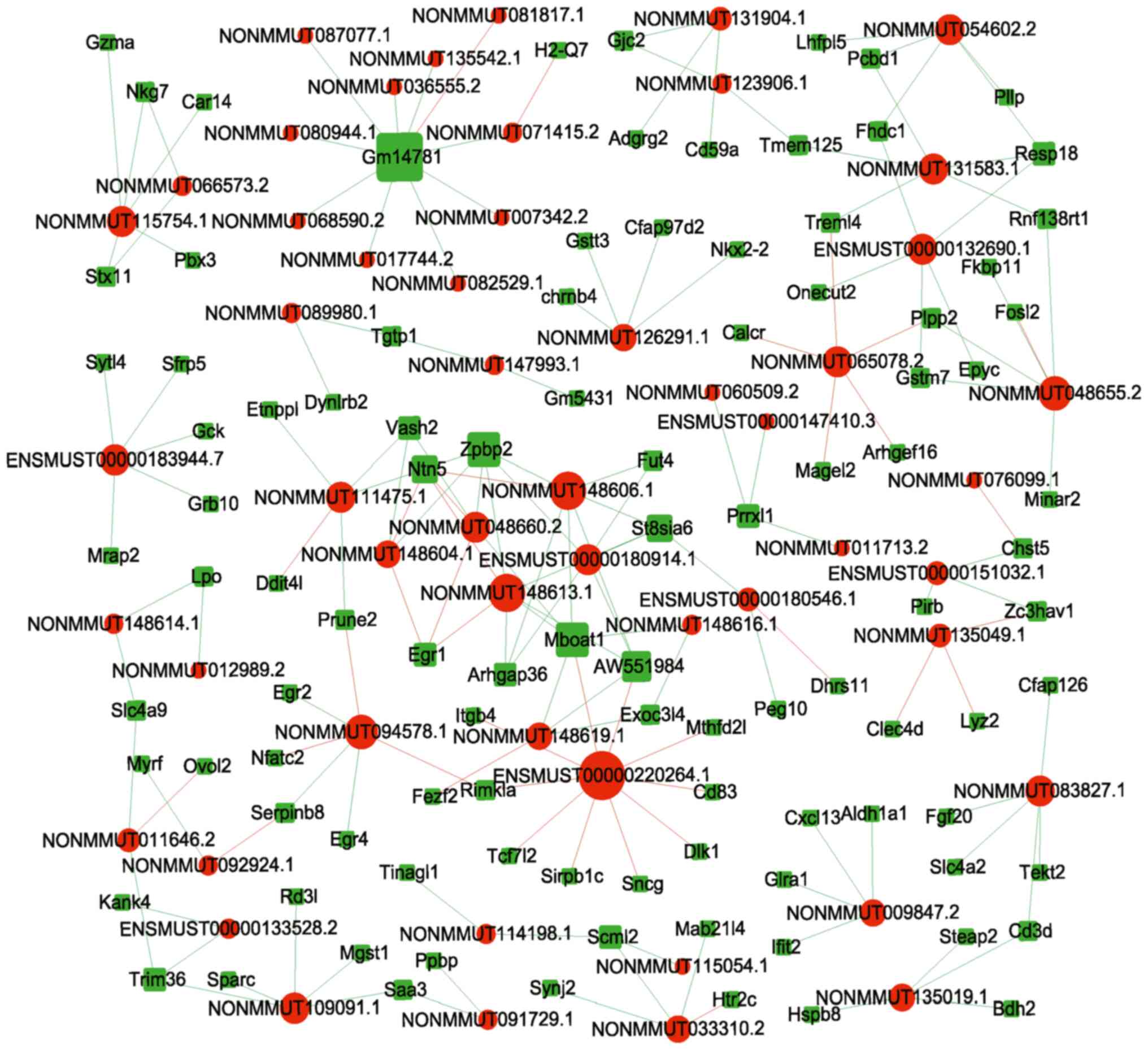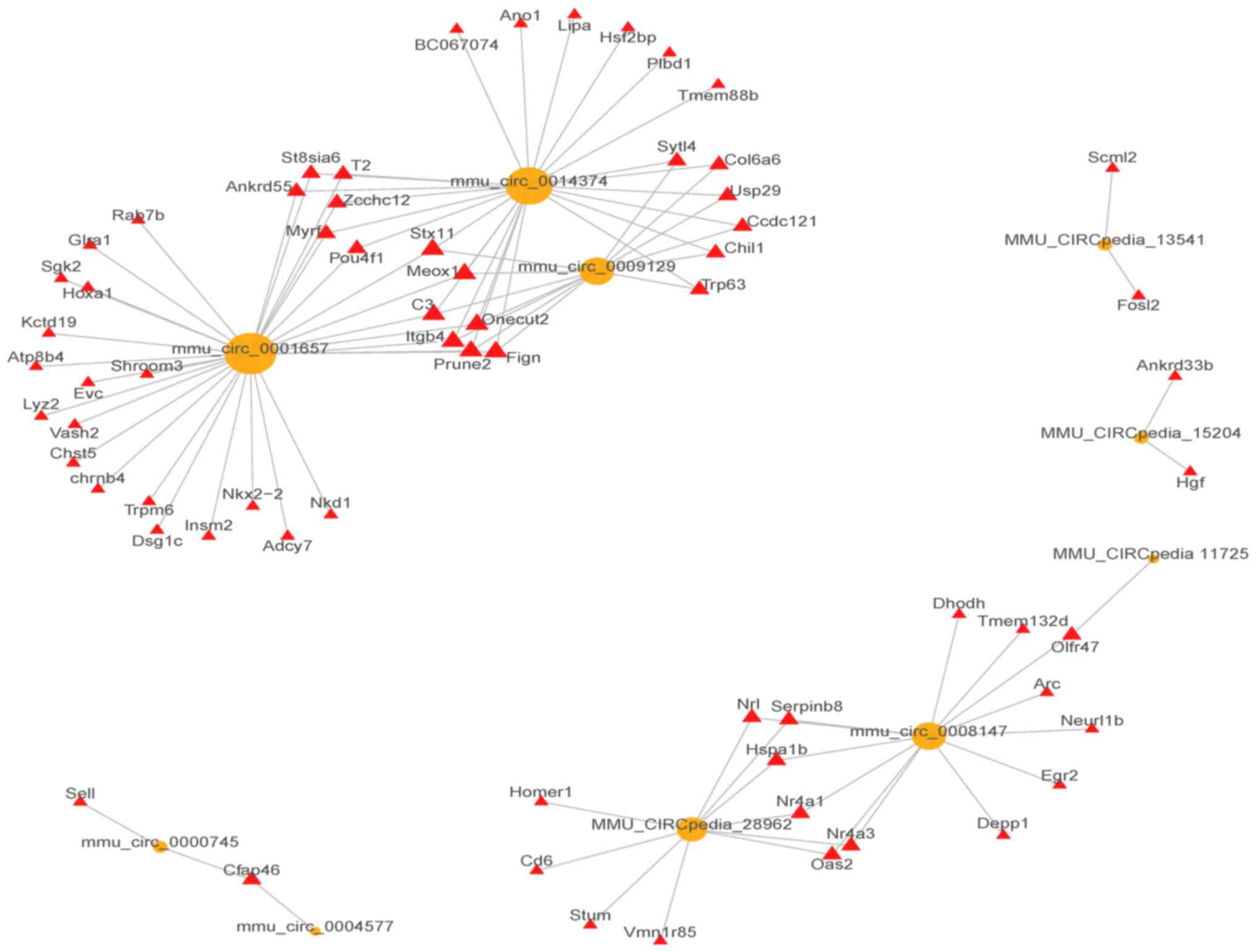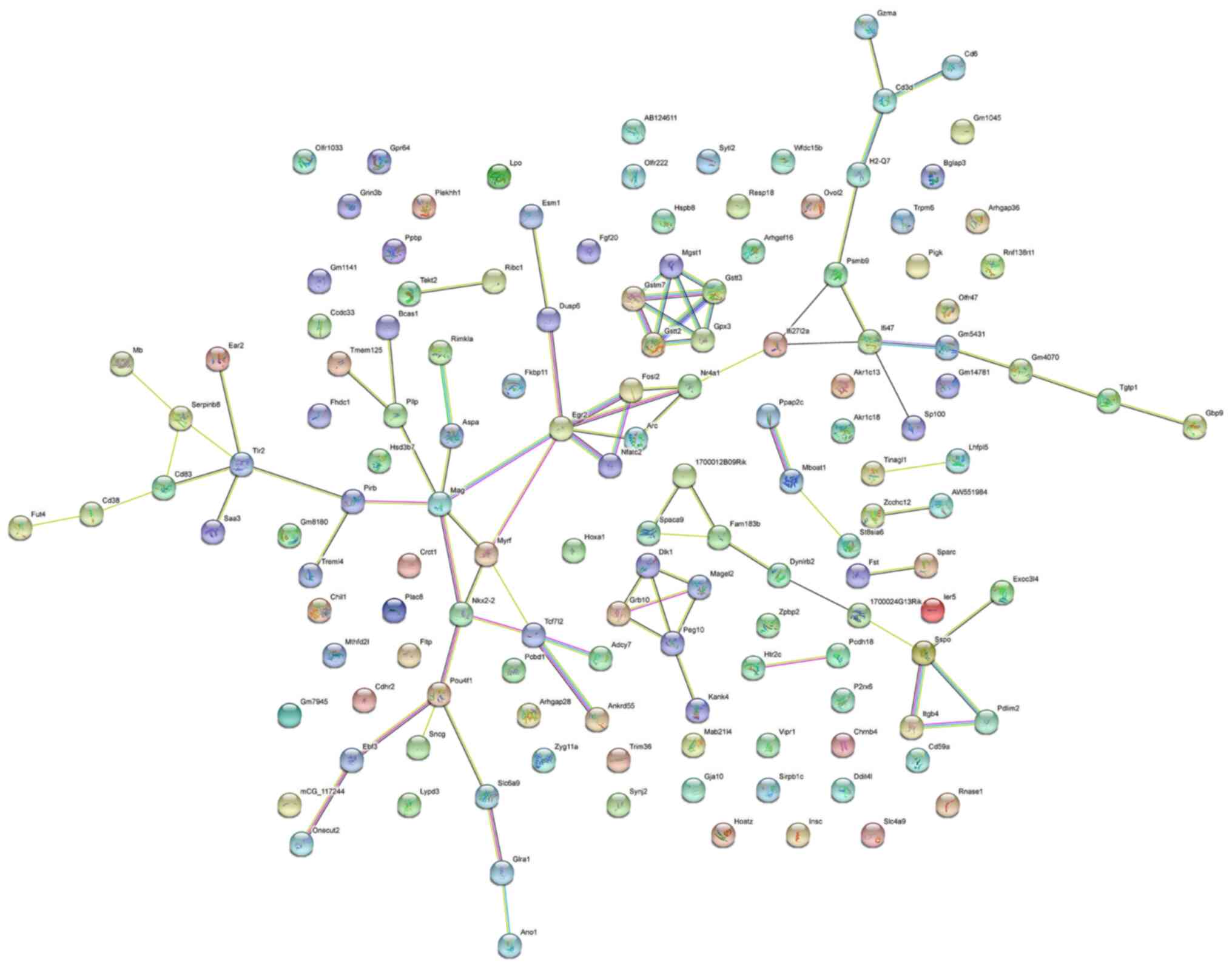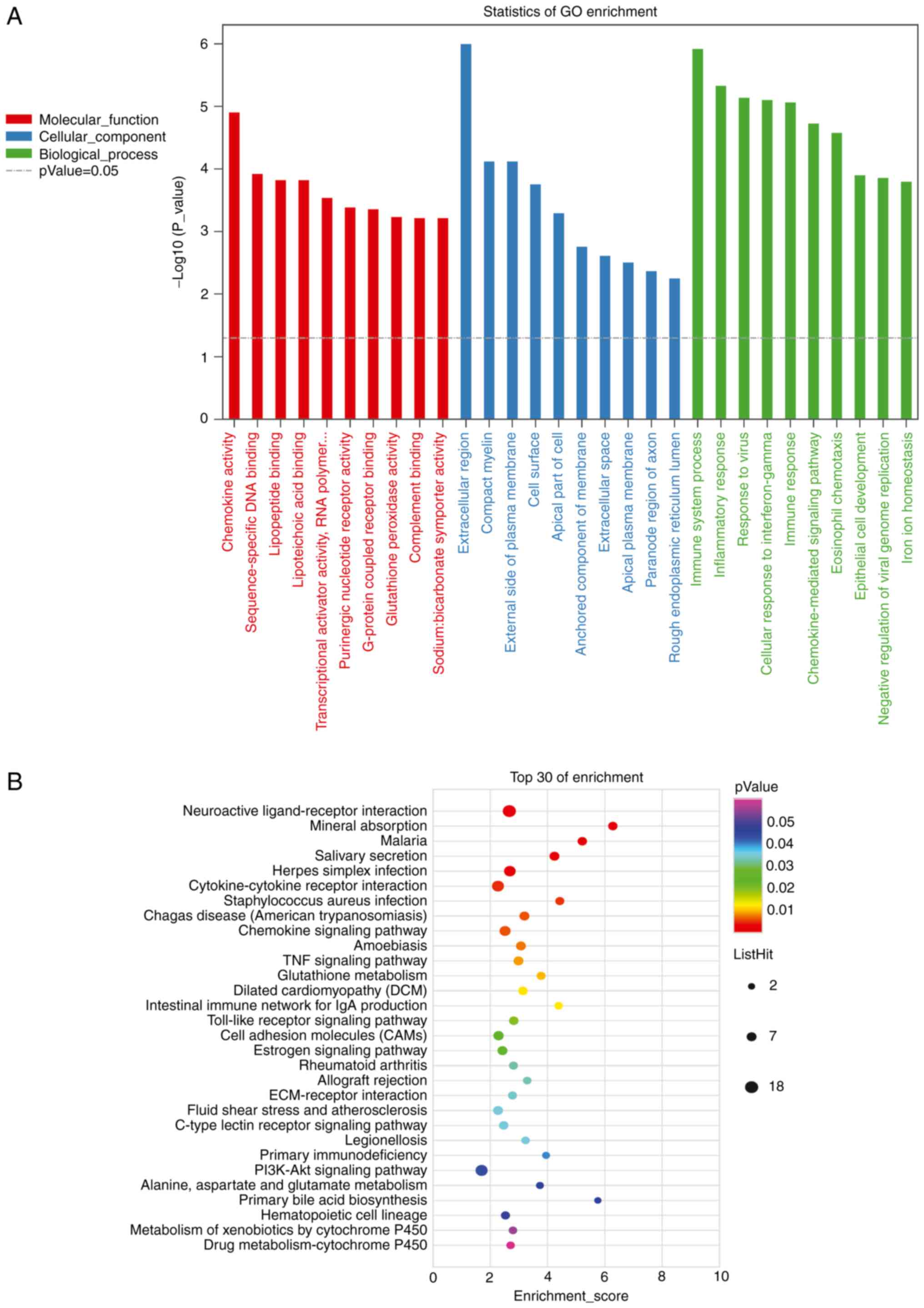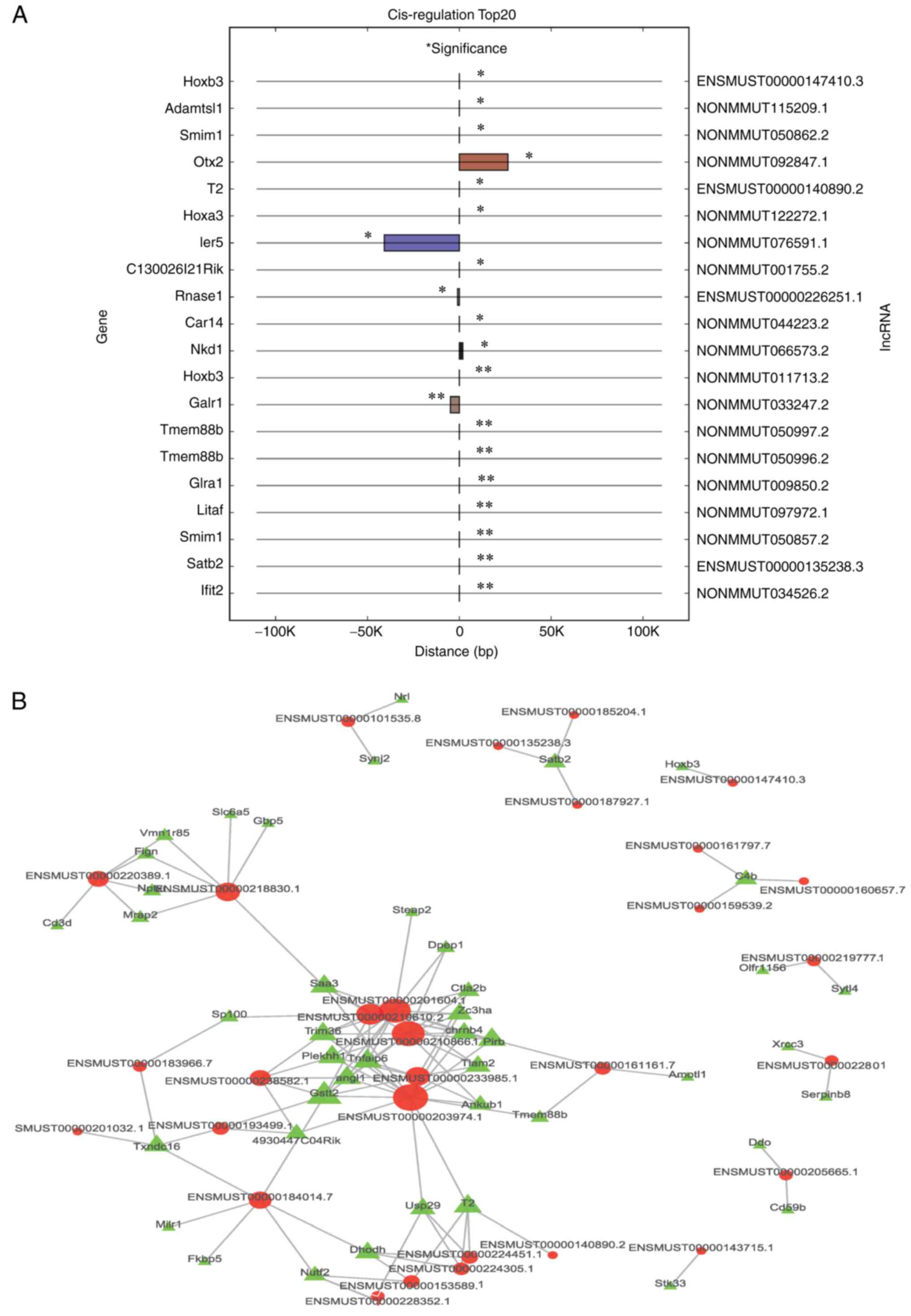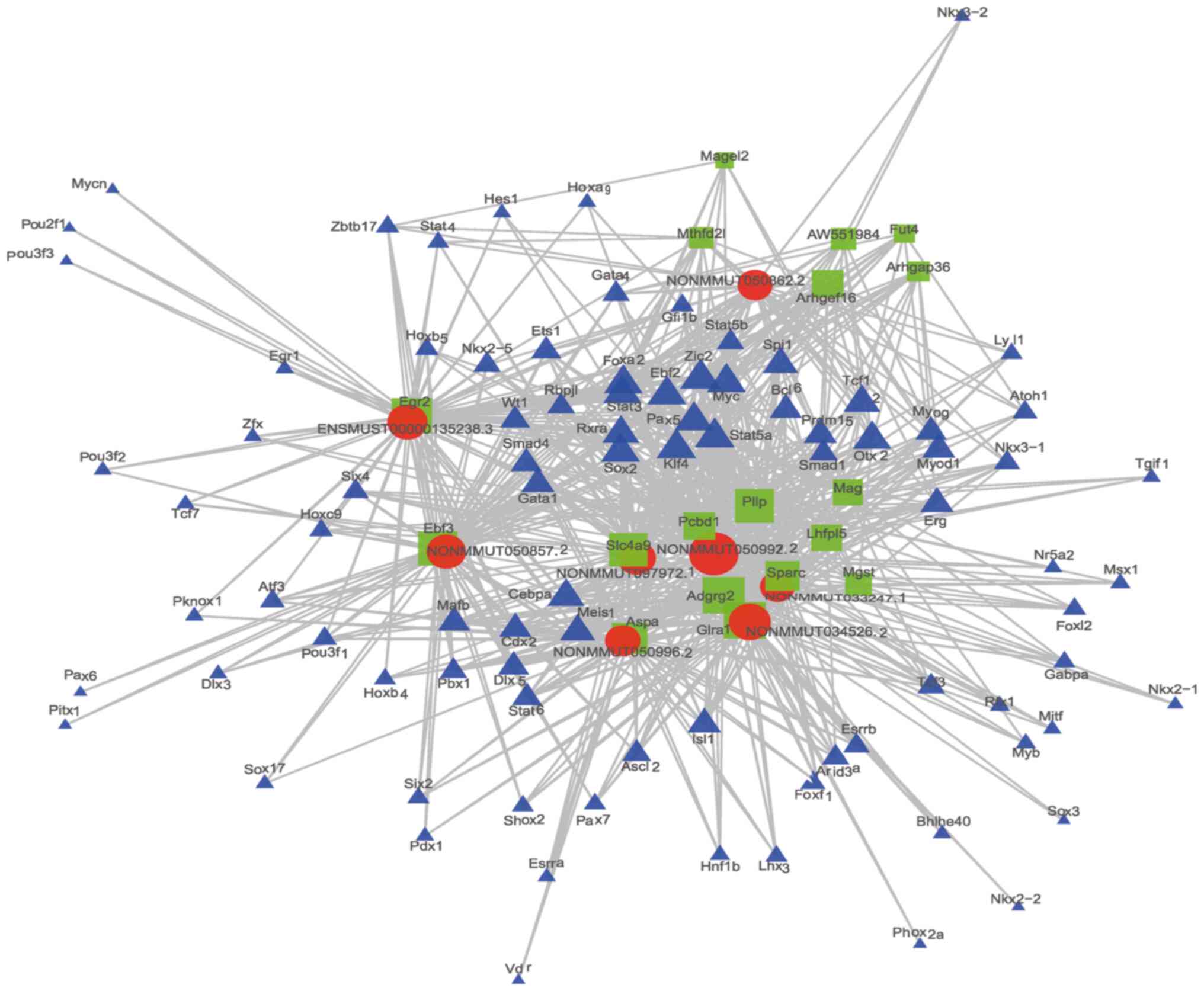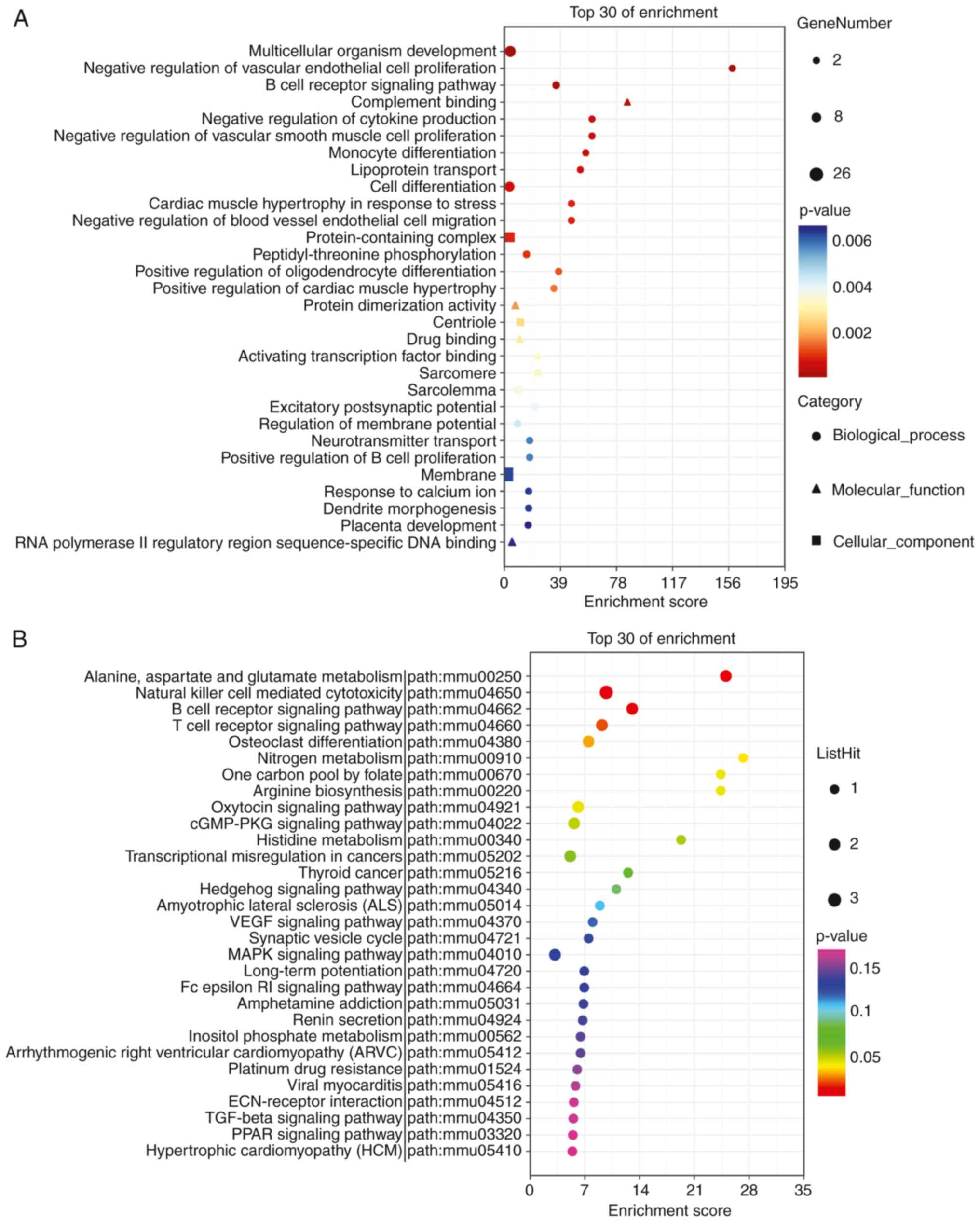|
1
|
Mucke L: Alzheimer's disease. Nature.
461:895–897. 2009.PubMed/NCBI View
Article : Google Scholar
|
|
2
|
Wenk GL: Neuropathologic changes in
Alzheimer's disease. J Clin Psychiatry. 64:7–10. 2003.PubMed/NCBI
|
|
3
|
Du Q, Zhu X and Si J: Angelica
polysaccharide ameliorates memory impairment in Alzheimer's disease
rat through activating BDNF/TrkB/CREB pathway. Exp Biol Med
(Maywood). 245:1–10. 2020.PubMed/NCBI View Article : Google Scholar
|
|
4
|
Zhou B, Tan J, Zhang C and Wu Y:
Neuroprotective effect of polysaccharides from Gastrodia elata
blume against corticosterone-induced apoptosis in PC12 cells via
inhibition of the endoplasmic reticulum stress-mediated pathway.
Mol Med Rep. 17:1182–1190. 2018.PubMed/NCBI View Article : Google Scholar
|
|
5
|
Wei M, Liu Y, Pi Z, Li S, Hu M, He Y, Yue
K, Liu T and Liu Z, Song F and Liu Z: Systematically characterize
the anti-Alzheimer's disease mechanism of lignans from S. chinensis
based on in-vivo ingredient analysis and target-network
pharmacology strategy by UHPLC-Q-TOF-MS. Molecules.
24(1203)2019.PubMed/NCBI View Article : Google Scholar
|
|
6
|
Guo X, Ye YJ, Song K, An LP and Sheng Y:
Mechanism of schisandrae chinensis fructus lignans in alleviating
learning and memory ability in D-galactose aging mice. Chin J Exp
Trad Med Formulae. 26:85–91. 2020.
|
|
7
|
Wu J, Qu JQ, Zhou YJ, Zhou YJ, Li YY,
Huang NQ, Deng CM and Luo Y: Icariin improves cognitive deficits by
reducing the deposition of β-amyloid peptide and inhibition of
neurons apoptosis in SAMP8 mice. Neuroreport. 31:663–671.
2020.PubMed/NCBI View Article : Google Scholar
|
|
8
|
Li Z, Zhang XB, Gu JH, Zeng YQ and Li JT:
Breviscapine exerts neuroprotective effects through multiple
mechanisms in APP/PS1 transgenic mice. Mol Cell Biochem. 468:1–11.
2020.PubMed/NCBI View Article : Google Scholar
|
|
9
|
Chen Y, Chen Y, Liang Y, Chen H, Ji X and
Huang M: Berberine mitigates cognitive decline in an Alzheimer's
disease mouse model by targeting both tau hyperphosphorylation and
autophagic clearance. Biomed Pharmacother.
121(109670)2020.PubMed/NCBI View Article : Google Scholar
|
|
10
|
Quan QK, Li X, Feng JJ, Hou JX, Li M and
Zhang BW: Ginsenoside Rg1 reduces β-amyloid levels by inhibiting
CDΚ5-induced PPARγ phosphorylation in a neuron model of Alzheimer's
disease. Mol Med Rep. 22:3277–3288. 2020.PubMed/NCBI View Article : Google Scholar
|
|
11
|
Zhang B, Li Q, Chu X, Sun S and Chen S:
Salidroside reduces tau hyperphosphorylation via up-regulating
GSK-3β phosphorylation in a tau transgenic Drosophila model of
Alzheimer's disease. Transl Neurodegener. 5:1–6. 2016.PubMed/NCBI View Article : Google Scholar
|
|
12
|
Bao J, Liu W, Zhou HY, Gui YR, Yan YH, Wu
MJ, Xiao YF, Shang JT, Long GF and Shu XJ:
Epigallocatechin-3-gallate alleviates cognitive deficits in APP/PS1
mice. Curr Med Sci. 40:18–27. 2020.PubMed/NCBI View Article : Google Scholar
|
|
13
|
Hase T, Shishido S, Yamamoto S, Yamashita
R, Nukima H, Taira S, Toyoda T, Abe K, Hamaguchi T, Ono K, et al:
Rosmarinic acid suppresses Alzheimer's disease development by
reducing amyloid β aggregation by increasing monoamine secretion.
Sci Rep. 9:1–13. 2019.PubMed/NCBI View Article : Google Scholar
|
|
14
|
Luo J, Song W, Xu Y, Chen GY, Hu Q and Tao
QW: Benefits and safety of tripterygium glycosides and total
glucosides of paeony for rheumatoid arthritis: An overview of
systematic reviews. Chin J Integr Med. 25:696–703. 2019.PubMed/NCBI View Article : Google Scholar
|
|
15
|
Wu X, Huang Y, Zhang Y, He C, Zhao Y, Wang
L and Gao J: Efficacy of tripterygium glycosides combined with ARB
on diabetic nephropathy: A meta-analysis. Biosci Rep.
40(BSR20202391)2020.PubMed/NCBI View Article : Google Scholar
|
|
16
|
Li T, Zhou HC and Chen J: Effects of
tripterygium wilfordii polyglycosides on the proliferation,
apoptosis and PI3K/AKT signaling pathway of human oral cancer KB
cells. J Guangdong Coll Pharm. 35:653–657. 2019.(In Chinese).
|
|
17
|
Ma CL, Zhang BL and Liu XM: Effects of
tripterygium glycosides on migration and angiogenesis of lung
adenocarcinoma cell by inhibiting PI3K/AKT signaling. Anhui Med
Pharm J. 26:235–238. 2022.(In Chinese).
|
|
18
|
Wang M, Chen TG, Yang XL, Zhang DL, Zhou
KS, Nan W and Zhang HH: Effect of tripterygium glycosides on
inflammatory factors induced by lipopolysaccharide in rat
astrocytes. Chin J Clin Pharmacol. 35:154–158. 2019.(In
Chinese).
|
|
19
|
Tang L, Xiang Q, Xiang J, Zhang Y and Li
J: Tripterygium glycoside ameliorates neuroinflammation in a mouse
model of Aβ25-35-induced Alzheimer's disease by
inhibiting the phosphorylation of IκBα and p38. Bioengineered.
12:8540–8554. 2021.PubMed/NCBI View Article : Google Scholar
|
|
20
|
Sun X and Malhotra A: Noncoding RNAs
(ncRNA) in hepato cancer: A review. J Environ Pathol Toxicol Oncol.
37:15–25. 2018.PubMed/NCBI View Article : Google Scholar
|
|
21
|
Faghihi M, Modarresi F, Khalil AM, Wood
DE, Sahagan BG, Morgan TE, Finch CE, Laurent GS III, Kenny PJ and
Wahlestedt C: Expression of a noncoding RNA is elevated in
Alzheimer's disease and drives rapid feed-forward regulation of
β-secretase. Nat Med. 14:723–730. 2008.PubMed/NCBI View
Article : Google Scholar
|
|
22
|
Massone S, Vassallo I, Fiorino G,
Castelnuovo M, Barbieri F, Borghi R, Tabaton M, Robello M, Gatta E,
Russo C, et al: 17A, a novel non-coding RNA, regulates GABA B
alternative splicing and signaling in response to inflammatory
stimuli and in Alzheimer disease. Neurobiol Dis. 41:308–317.
2011.PubMed/NCBI View Article : Google Scholar
|
|
23
|
Massone S, Ciarlo E, Vella S, Nizzari M,
Florio T, Russo C, Cancedda R and Pagano A: NDM29, a RNA polymerase
III-dependent non coding RNA, promotes amyloidogenic processing of
APP and amyloid β secretion. Biochim Biophys Acta. 1823:1170–1177.
2012.PubMed/NCBI View Article : Google Scholar
|
|
24
|
Ciarlo E, Massone S, Penna I, Nizzari M,
Gigoni A, Dieci G, Russo C, Florio T, Cancedda R and Pagano A: An
intronic ncRNA-dependent regulation of SORL1 expression affecting
Aβ formation is upregulated in post-mortem Alzheimer's disease
brain samples. Dis Model Mech. 6:424–433. 2013.PubMed/NCBI View Article : Google Scholar
|
|
25
|
Mus E, Hof PR and Tiedge H: Dendritic
BC200 RNA in aging and in Alzheimer's disease. Proc Natl Acad Sci
USA. 104:10679–10684. 2007.PubMed/NCBI View Article : Google Scholar
|
|
26
|
Parenti R, Paratore S, Torrisi A and
Cavallaro S: A natural antisense transcript against Rad18,
specifically expressed in neurons and upregulated during
beta-amyloid-induced apoptosis. Eur J Neurosci. 26:2444–2457.
2007.PubMed/NCBI View Article : Google Scholar
|
|
27
|
Verduci L, Tarcitano E, Strano S, Yarden Y
and Blandino G: CircRNAs: Role in human diseases and potential use
as biomarkers. Cell Death Dis. 12:1–12. 2021.PubMed/NCBI View Article : Google Scholar
|
|
28
|
Dube U, Del-Aguila JL, Li Z, Budde JP,
Jiang S, Hsu S, Ibanez L, Fernandez MV, Farias F, Norton J, et al:
An atlas of cortical circular RNA expression in Alzheimer disease
brains demonstrates clinical and pathological associations. Nat
Neurosci. 22:1903–1912. 2019.PubMed/NCBI View Article : Google Scholar
|
|
29
|
Ma N, Pan J, Ye X, Yu B, Zhang W and Wan
J: Whole-transcriptome analysis of APP/PS1 mouse brain and
identification of circRNA-miRNA-mRNA networks to investigate AD
pathogenesis. Mol Ther Nucleic Acids. 18:1049–1062. 2019.PubMed/NCBI View Article : Google Scholar
|
|
30
|
Gruner H, Cortes-Lopez M, Cooper DA, Bauer
M and Miura P: CircRNA accumulation in the aging mouse brain. Sci
Rep. 6(38907)2016.PubMed/NCBI View Article : Google Scholar
|
|
31
|
National Research Council (US) Institute
for Laboratory Animal Research. Guide for the Care and Use of
Laboratory Animals. National Academies Press, Washington, DC,
1996.
|
|
32
|
Ritchie ME, Phipson B, Wu D, Hu Y, Law CW,
Shi W and Smyth GK: limma powers differential expression analyses
for RNA-sequencing and microarray studies. Nucleic Acids Res.
43(e47)2015.PubMed/NCBI View Article : Google Scholar
|
|
33
|
R Core Team: R: A language and environment
for statistical computing. R Foundation for Statistical Computing,
Vienna, 2012. http://www.R-project.org/.
|
|
34
|
RStudio Team: RStudio, Integrated
Development for R. RStudio, Inc., Boston MA, 2015. http://www.rstudio.com/.
|
|
35
|
Saeed AI, Sharov V, White J, Li J, Liang
W, Bhagabati N, Braisted J, Klapa M, Currier T, Thiagarajan M, et
al: TM4: A free, open-source system for microarray data management
and analysis. Biotechniques. 34:374–378. 2003.PubMed/NCBI View Article : Google Scholar
|
|
36
|
Livak KJ and Schmittgen TD: Analysis of
relative gene expression data using real-time quantitative PCR and
the 2(-Delta Delta C(T)) method. Methods. 25:402–408.
2001.PubMed/NCBI View Article : Google Scholar
|
|
37
|
Krzywinski M, Schein J, Birol I, Connors
J, Gascoyne R, Horsman D, Jones SJ and Marra MA: Circos: An
information aesthetic for comparative genomics. Genome Res.
19:1639–1645. 2009.PubMed/NCBI View Article : Google Scholar
|
|
38
|
Szklarczyk D, Gable AL, Lyon D, Junge A,
Wyder S, Huerta-Cepas J, Simonovic M, Doncheva NT, Morris JH, Bork
P, et al: STRING v11: protein-protein association networks with
increased coverage, supporting functional discovery in genome-wide
experimental datasets. Nucleic Acids Res. 47:D607–D613.
2019.PubMed/NCBI View Article : Google Scholar
|
|
39
|
Ashburner M, Ball C, Blake J, Botstein D,
Butler H, Cherry JM, Davis AP, Dolinski K, Dwight SS, Eppig JT, et
al: Gene ontology: Tool for the unification of biology. The gene
ontology consortium. Nat Genet. 25:25–29. 2000.PubMed/NCBI View Article : Google Scholar
|
|
40
|
The Gene Ontology Consortium. The gene
ontology resource: 20 years and still GOing strong. Nucleic Acids
Res. 47:D330–D338. 2019.PubMed/NCBI View Article : Google Scholar
|
|
41
|
Kanehisa M: Post-genome Informatics.
Oxford University press Inc., New York, NY, 2000.
|
|
42
|
Wucher V, Legeai F, Hedan B, Rizk G,
Lagoutte L, Leeb T, Jagannathan V, Cadieu E, David A, Lohi H, et
al: FEELnc: A tool for long non-coding RNA annotation and its
application to the dog transcriptome. Nucleic Acids Res.
45(e57)2017.PubMed/NCBI View Article : Google Scholar
|
|
43
|
Alkan F, Wenzel A, Palasca O, Kerpedjiev
P, Rudebeck AF, Stadler PF, Hofacker IL and Gorodkin J: RIsearch2:
Suffix array-based large-scale prediction of RNA-RNA interactions
and siRNA off-targets. Nucleic Acids Res. 45(e60)2017.PubMed/NCBI View Article : Google Scholar
|
|
44
|
Wenzel A, Akbasli E and Gorodkin J:
RIsearch: Fast RNA-RNA interaction search using a simplified
nearest-neighbor energy model. Bioinformatics. 28:2738–2746.
2012.PubMed/NCBI View Article : Google Scholar
|
|
45
|
Shannon P, Markiel A, Ozier O, Baliga NS,
Wang JT, Ramage D, Amin N, Schwikowski B and Ideker T: Cytoscape: A
software environment for integrated models of biomolecular
interaction networks. Genome Res. 13:2498–2504. 2003.PubMed/NCBI View Article : Google Scholar
|
|
46
|
Shen Y, Peng X and Shen C: Identification
and validation of immune-related lncRNA prognostic signature for
breast cancer. Genomics. 112:2640–2646. 2020.PubMed/NCBI View Article : Google Scholar
|
|
47
|
Luo ZH, Walid AA, Xie Y, Long H, Xiao W,
Xu L, Fu Y, Feng L and Xiao B: Construction and analysis of a
dysregulated lncRNA-associated ceRNA network in a rat model of
temporal lobe epilepsy. Seizure. 69:105–114. 2019.PubMed/NCBI View Article : Google Scholar
|
|
48
|
Wei CW, Luo T, Zou SS and Wu AS: The role
of long noncoding RNAs in central nervous system and
neurodegenerative diseases. Front Behav Neurosci.
12(175)2018.PubMed/NCBI View Article : Google Scholar
|
|
49
|
Singh A, Kukreti R, Saso L and Kukreti S:
Oxidative stress: A key modulator in neurodegenerative diseases.
Molecules. 24(1583)2019.PubMed/NCBI View Article : Google Scholar
|
|
50
|
Yang Z, Jiang S, Shang J, Jiang Y, Dai Y,
Xu B, Yu Y, Liang Z and Yang Y: LncRNA: Shedding light on
mechanisms and opportunities in fibrosis and aging. Ageing Res Rev.
52:17–31. 2019.PubMed/NCBI View Article : Google Scholar
|
|
51
|
Swerdlow RH: Mitochondria and
mitochondrial cascades in Alzheimer's disease. J Alzheimers Dis.
62:1403–1416. 2018.PubMed/NCBI View Article : Google Scholar
|
|
52
|
Hezroni H, Perry RBT and Ulitsky I: Long
noncoding RNAs in development and regeneration of the neural
lineage. Cold Spring Harb Symp Quant Biol. 84:165–177.
2019.PubMed/NCBI View Article : Google Scholar
|
|
53
|
Tang L, Liu L, Li G, Jiang P, Wang Y and
Li J: Expression profiles of long noncoding RNAs in intranasal
LPS-mediated Alzheimer's disease model in mice. BioMed Res Int.
2019(9642589)2019.PubMed/NCBI View Article : Google Scholar
|
|
54
|
Deng M, Yang H, Xie X, Liang G and Gan L:
Comparative expression analysis of POU4F1, POU4F2 and ISL1 in
developing mouse cochleovestibular ganglion neurons. Gene Expr
Patterns. 15:31–37. 2014.PubMed/NCBI View Article : Google Scholar
|
|
55
|
Yadav R and Srivastava P: Establishment of
resveratrol and its derivatives as neuroprotectant against
monocrotophos-induced alteration in NIPBL and POU4F1 protein
through molecular docking studies. Environ Sci Pollut Res Int.
27:291–304. 2020.PubMed/NCBI View Article : Google Scholar
|
|
56
|
Jeanneteau F, Barrère C, Vos M, De Vries
CJM, Rouillard C, Levesque D, Dromard Y, Moisan MP, Duric V,
Franklin TC, et al: The stress-induced transcription factor NR4A1
adjusts mitochondrial function and synapse number in prefrontal
cortex. J Neurosci. 38:1335–1350. 2018.PubMed/NCBI View Article : Google Scholar
|
|
57
|
McNulty SE, Barrett RM, Vogel-Ciernia A,
Malvaez M, Hernandez N, Davatolhagh MF, Matheos DP, Schiffman A and
Wood MA: Differential roles for Nr4a1 and Nr4a2 in object location
vs. object recognition long-term memory. Learn Mem. 19:588–592.
2012.PubMed/NCBI View Article : Google Scholar
|
|
58
|
Zhang Z and Yu J: NR4A1 promotes cerebral
ischemia reperfusion injury by repressing Mfn2-mediated mitophagy
and inactivating the MAPK-ERK-CREB signaling pathway. Neurochem
Res. 43:1963–1977. 2018.PubMed/NCBI View Article : Google Scholar
|
|
59
|
Chen YL, Wang Y, Erturk A, Kallop D, Jiang
Z, Weimer RM, Kaminker J and Sheng M: Activity-induced Nr4a1
regulates spine density and distribution pattern of excitatory
synapses in pyramidal neurons. Neuron. 83:431–443. 2014.PubMed/NCBI View Article : Google Scholar
|
|
60
|
LeBlanc SE, Srinivasan R, Ferri C, Mager
GM, Gillian-Daniel AL, Wrabetz L and Svaren J: Regulation of
cholesterol/lipid biosynthetic genes by Egr2/Krox20 during
peripheral nerve myelination. J Neurochem. 93:737–748.
2005.PubMed/NCBI View Article : Google Scholar
|
|
61
|
Llorens F, Gil V and del Río JA: Emerging
functions of myelin-associated proteins during development,
neuronal plasticity, and neurodegeneration. FASEB J. 25:463–475.
2011.PubMed/NCBI View Article : Google Scholar
|
|
62
|
Wang Z, Xu P, Chen B, Zhang Z, Zhang C,
Zhan Q, Huang S, Xia ZA and Peng W: Identifying
circRNA-associated-ceRNA networks in the hippocampus of
Aβ1-42-induced Alzheimer's disease-like rats using
microarray analysis. Aging (Albany NY). 10:775–788. 2018.PubMed/NCBI View Article : Google Scholar
|
|
63
|
Zhang Y, Yu F, Bao S and Sun J: Systematic
characterization of circular RNA-associated CeRNA network
identified novel circRNA biomarkers in Alzheimer's disease. Front
Bioeng Biotechnol. 7(222)2019.PubMed/NCBI View Article : Google Scholar
|
|
64
|
Castillo E, Leon J, Mazzei G, Abolhassani
N, Haruyama N, Saito T, Saido T, Hokama M, Iwaki T, Ohara T, et al:
Comparative profiling of cortical gene expression in Alzheimer's
disease patients and mouse models demonstrates a link between
amyloidosis and neuroinflammation. Sci Rep. 7(17762)2017.PubMed/NCBI View Article : Google Scholar
|
|
65
|
Fielder E, Von Zglinicki T and Jurk D: The
DNA damage response in neurons: Die by apoptosis or survive in a
senescence-like state? J Alzheimer's Dis. 60:S107–S131.
2017.PubMed/NCBI View Article : Google Scholar
|
|
66
|
Coimbra-Costa D, Alva N, Duran M, Carbonel
T and Rama R: Oxidative stress and apoptosis after acute
respiratory hypoxia and reoxygenation in rat brain. Redox Biol.
12:216–225. 2017.PubMed/NCBI View Article : Google Scholar
|
|
67
|
Galluzzi L, Pedro JMBS, Blomgren K and
Kroemer G: Autophagy in acute brain injury. Nat Rev Neurosci.
17:467–484. 2016.PubMed/NCBI View Article : Google Scholar
|
|
68
|
Wang G, Han B, Shen L, Wu S, Yang L, Liao
J, Wu F, Li M, Leng S, Zang F, et al: Silencing of circular RNA
HIPK2 in neural stem cells enhances functional recovery following
ischaemic stroke. EBioMedicine. 52(102660)2020.PubMed/NCBI View Article : Google Scholar
|
|
69
|
Yang M, Xiang G, Yu D, Yang G, He W, Yang
S, Zhou G and Liu A: Hsa_circ_0002468 regulates the neuronal
differentiation of SH-SY5Y cells by modulating the MiR-561/E2F8
axis. Med Sci Monit. 25:2511–2519. 2019.PubMed/NCBI View Article : Google Scholar
|
|
70
|
Zhang N, Gao Y, Yu S, Sun XH and Shen K:
Berberine attenuates Aβ42-induced neuronal damage through
regulating circHDAC9/miR-142-5p axis in human neuronal cells. Life
Sci. 252(117637)2020.PubMed/NCBI View Article : Google Scholar
|
|
71
|
Yang H, Wang H, Shang H, Chen X, Yang S,
Qu Y, Ding J and Li X: Circular RNA circ_0000950 promotes neuron
apoptosis, suppresses neurite outgrowth and elevates inflammatory
cytokines levels via directly sponging miR-103 in Alzheimer's
disease. Cell Cycle. 18:2197–2214. 2019.PubMed/NCBI View Article : Google Scholar
|
|
72
|
Shi Z, Chen T, Yao Q, Zheng L, Zhang Z,
Wang J, Hu Z, Cui H, Han Y, Han X, et al: The circular RNA cirs-7
promotes APP and BACE 1 degradation in an NF-κB-dependent manner.
FEBS J. 284:1096–1109. 2017.PubMed/NCBI View Article : Google Scholar
|
|
73
|
Li Y, Lv Z, Zhang J, Ma Q, Li Q, Song L,
Gong L, Zhu Y, Li X, Hao Y and Yang Y: Profiling of differentially
expressed circular RNAs in peripheral blood mononuclear cells from
Alzheimer's disease patients. Metab Brain Dis. 35:201–213.
2020.PubMed/NCBI View Article : Google Scholar
|
|
74
|
Chen D, Guo Y, Qi L, Tang X, Liu Y, Yang
X, Hu GY, Shuai Q, Yong Y, Wang D, et al: Circular RNA NF1-419
enhances autophagy to ameliorate senile dementia by binding
Dynamin-1 and adaptor protein 2 B1 in AD-like mice. Aging (Albany
NY). 11:12002–12031. 2019.PubMed/NCBI View Article : Google Scholar
|
|
75
|
Han B, Zhang Y, Zhang Y, Bai Y, Chen XF,
Huang R, Wu FF, Shou L, Chao J, Zhang J, et al: Novel insight into
circular RNA HECTD1 in astrocyte activation via autophagy by
targeting MIR142-TIPARP: Implications for cerebral ischemic stroke.
Autophagy. 14:1164–1184. 2018.PubMed/NCBI View Article : Google Scholar
|















